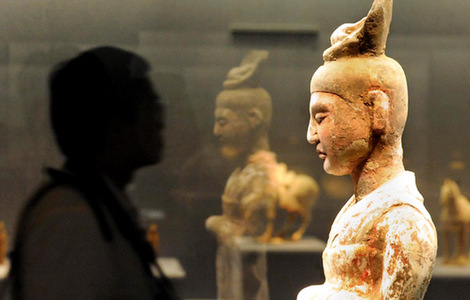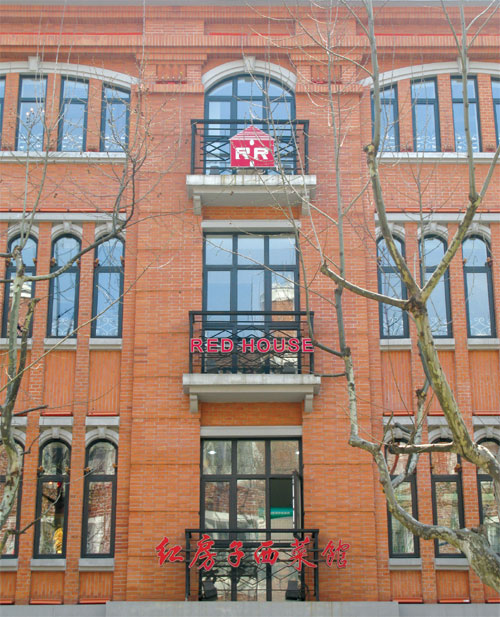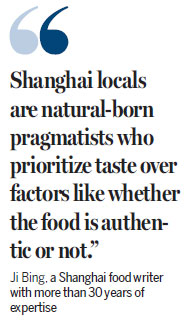Chopsticks for my steak, please
Updated: 2015-05-01 09:57
By Xu Junqian in Shanghai(China Daily USA)
|
||||||||
|
Red House, one of the first restaurants to serve the city's homemade Western cuisine, evokes important or romantic memories for many older local residents. [Gao Erqiang / China Daily] |
Shanghai has long had a fondness for Western dishes mixed to its own tastes. The cuisine, known as hai pai, still has a special place in the hearts of locals.
Xiaolongbao (soup dumplings), red-braised pork and hairy crab may have topped every food list compiled by every travel guide for the city of Shanghai.
But one particular type of cuisine is uniquely Shanghainese. It is served in some of the city's most historic and well-preserved buildings and has been eaten by locals on important or romantic occasions for generations.
Known as hai pai xi can, Shanghai's own brand of Western cuisine incorporates elements of French, Italian and German cooking into the local culinary repertoire. It could be compared to the kind of Chinese food sold in Chinatowns across the United States - authentic dishes given a tailored twist.
"It's a kind of Western cuisine that you can use chopsticks to eat, even though most people wouldn't," said Kong Mingzhu, a famous Shanghai food writer. She was speaking at Shanghai Colormen, an invitation-only cultural salon held once a month.
In April, it decided to take an epicurean look back in history.
Staple hai pai dishes include potato salad, fried pork chop and Russian borscht (a beetroot-based soup that actually originated in the Ukraine). In kitchens across the city, these three dishes serve as a litmus test to decide whether the mistress of the house has mastered the local cooking arts.
Yet all of the dishes are different from how they are classically prepared.
Vegetables are absent from the potato salad, which derives from the Moscow classic. Instead, potatoes and processed hams are chopped into dice-sized cubes and mixed with a special salad sauce made from egg yolk and cooking oil. The result is a creamy, sweet concoction.
Fried pork chop remains truer to the Vienna cutlet from which it is derived. But the spicy soy sauce makes it Shanghai's own. Local gourmets are so particular about the sauce that they insist on using only one brand. They are convinced that the slightly spicy, lip-puckering sauce cuts through the greasiness of the pork chop to make it the perfect companion.
The Russian soup, which is better known here as luosong because it sounds similar in Shanghai dialect to the word "Russian", has little to do with the original. As beetroot was not grown in China, it has been transformed into a tomato paste-based soup featuring a hotchpotch of vegetables and a handful of sausage slices.
"Every dish follows two principles: use the most available ingredients and adapt it to local tastes," said Hou Genquan, a retired chef from Red House, the most sought-after restaurant in the city for this kind of cuisine.
Opened in 1935 by a Jewish-Italian man and his French wife, Red House was originally named Chez Revere and located on Huaihai Road, the Fifth Avenue of Shanghai. For decades, people have queued patiently in long lines outside the red-brick restaurant - similar to the phenomenon caused whenever Apple launches a new product here.
"Of course we had regular dishes like steaks and sauted mushroom soup, but they never managed to be bestsellers," said Hou.
Ji Bing, a local food writer with 30 years' expertise, said Shanghai locals are natural-born pragmatists who prioritize taste over factors like whether the food is authentic or not. Generally, pork is favored over beef in China and soups are more popular when they contain a number of ingredients.
When baked snails were introduced into the city, some restaurants invented varieties like baked clams or shrimps to satisfy the growing appetite and "they sold like hot cakes," Ji said.
The varieties sold well because such eateries were rare at the time, when frugality prevailed and dining out was rarely encouraged.
There have never been that many restaurants serving hai pai cuisine, said Huang Tiemin, director of the Shanghai Restaurant Association. He estimated the number to be less than a dozen.
Huang noted that in the early days, such restaurants were considered exclusive and enjoyed only by the rich or, on occasion, the less wealthy who were celebrating an important occasion. In Shanghai dialect, going for some Western cuisine is colloquially called kai yang hun, which roughly translates as "taste foreign meat and fish".
As incomes started to climb in the 1990s, driving out to dine became more popular and crowds of fancy restaurants sprouted up to dominate the market.
"Nowadays, young people would rather go to real Western-style restaurants and fork out more for an authentic steak or sauted mushroom soup," Huang said.
Shanghai native Zhou Yongle may not agree. He opened his restaurant Tian'e Shen Ge (literally, Swan Shanghai Chamber) in 2008 because he couldn't find his favorite childhood dishes anywhere in the city. His restaurant is named in homage to Tian'e Ge, a rival of Red House in the 1940s and 1950s that was frequented by the city's yuppies. It closed down in the 1990s.
The scion of a wealthy family, Zhou remembers dressing up and going for a feast at Tian'e Ge every weekend. "They were the happiest memories of my childhood," he said.
After spending several decades living and working in the United States, he returned to Shanghai in 1998. The idea of starting a restaurant arose from his cravings for certain pork dishes he was unable to find.
"I had had enough Western cuisine but the Shanghai style was ultimately the one I missed the most," he said.
Now diners of his generation fill his small restaurant, which can accommodate nearly 50 people, almost every day. Many bring their children, meaning that hai pai should continue to have a future in the city.
xujunqian@chinadaily.com.cn

 Chinese rescuers work on outskirts of Kathmandu, Nepal
Chinese rescuers work on outskirts of Kathmandu, Nepal
 Mother throws million-yuan fashion show for daughter's birthday
Mother throws million-yuan fashion show for daughter's birthday
 Memory lane
Memory lane
 Across America over the week (from April 24 to 30)
Across America over the week (from April 24 to 30)
 Across Canada (May 1)
Across Canada (May 1)
 China's top 10 GDP provinces in Q1
China's top 10 GDP provinces in Q1
 Photos capture marvelous landscapes of China
Photos capture marvelous landscapes of China
 Mass exodus from Kathmandu
Mass exodus from Kathmandu
Most Viewed
Editor's Picks

|

|

|

|

|

|
Today's Top News
Abe protests continue in San Francisco
China's real estate approach lauded
May Day holiday will not be a boom for HK retailers: Analyst
Stay out of our affairs, China
tells outsiders
Abe betrays history's conscience
The 'nightmare' everyone saw coming
Vancouver property developer identified as Chinese fugitive: report
Freddie Gray tried to hurt himself in police van
US Weekly

|

|








